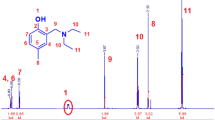Summary
The radical melt polymerization of 2-[4-(6-methacryloyloxyhexa-1,6-diyloxy)phenylazo]-anthraquinone is described yielding the homopolymer p m with the number average molecular weight (M n ) of M n =74kg/mol determined by gel permeation chromatography (GPC) using polystyrene (PS) calibration. The redox properties of a thin film of p m were investigated by cyclic voltammetry. Two reversible redox waves were found at all applied sweep rates indicating two reversible electron (E) transfer processes of the anthraquinone units according the EE-mechanism. A thin film of the randomlike copolymethacrylate cp r with the molar mass of M n =73kg/mol was investigated, too. The sidegroups of cp r are substituted by 77mol% with benzyl, by 22mol% with phenylazoanthraquinone and by 1mol% with COOH groups. The redox properties of cp r depend on the timescale of the cyclovoltammetric experiment. At high sweep rates two reversible redox waves are observable corresponding to the EE-mechanism. At low sweep rates an additional reversible redox wave appears, which is essentially smaller than the other two. The third wave is explained to be a result of hydrogen bonding between the COOH groups and anthraquinone mono- and dianions. The most anthraquinone units are reduced according the EE-mechanism without hydrogen bonding due to statistical reasons. The reversible redox properties of p m and cp r are closely connected to their molar masses (M n ≈75kg/mol), because both polymers have been previously obtained by radical solution polymerization yielding low molecular products with molar masses of M n ≈10kg/mol. The low molecular polymers have shown an irreversible redox behaviour. Therefore, it could be demonstrated that the molar mass of an electroactive polymer significantly affects its redox properties.
Similar content being viewed by others
Author information
Authors and Affiliations
Additional information
Received: 13 November 1998/Revised version: 30 March 1999/Accepted: 20 April 1999
Rights and permissions
About this article
Cite this article
Leitner, M. Reversible redox behaviour of two electroactive polymethacrylates. Polymer Bulletin 42, 567–574 (1999). https://doi.org/10.1007/s002890050503
Issue Date:
DOI: https://doi.org/10.1007/s002890050503




